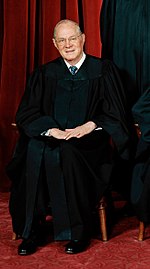Yarborough v. Alvarado
Michael Alvarado helped his friend Paul Soto steal a truck in Santa Fe Springs, California.The respondent Michael Alvarado agreed to help his friend Paul Soto steal a truck in the parking lot of a shopping mall in Santa Fe Springs, California.[7] Alvarado's habeas corpus petition thus depended on demonstrating that the state court's custody determination was more than debatable, but objectively incorrect.[10] California Deputy Attorney General Deborah Chuang argued that the Ninth Circuit's ruling was not consistent with precedent because the Supreme Court had never addressed using age as a factor in custody analysis.[12] John P. Elwood, at the time assistant to the Solicitor General, argued that age doesn't make a legal difference for Miranda purposes because it is a rule uniformly applied to all people[13] and that police officers should not be required to get inside the head of each suspect.[14] Tara K. Allen, arguing for Alvarado, claimed that the state court's decision was objectively unreasonable because they did not consider the totality of the circumstances surrounding the investigation as required by Thompson v.Associate Justice Antonin Scalia responded by saying that, according to Thompson v. Keohane, custody is an objective test[17] and subjective factors like characteristics of the individual do not matter.[22] Central to the reversal of the Ninth Circuit was the fact that the state court did not take into account Alvarado's age and experience with law enforcement in the custody analysis.[23] Associate Justice Sandra Day O'Connor wrote a concurrence that agreed with the finding that the state court's decision was reasonable.The note argued that establishing such broad legal precedent was outside the bounds of the authority of the Ninth Circuit and the Supreme Court was right to reverse.[31] Berry Feld, professor at University of Minnesota Law School, wrote: "the Court's decision ... treated juveniles as the functional equals of adults during interrogation.Over the past quarter-century, developmental psychological research consistently has emphasized adolescents' inability to understand or exercise Miranda rights".[32] Paul Holland, professor at Seattle University School of Law, wrote that "the assumptions Justice Kennedy made in Alvarado are inapplicable to the schoolhouse context ... considering the age of a student-suspect questioned at school, would not present a significant risk of compromising the clarity the Court has sought to provide law enforcement.



Supreme Court of the United StatesL. Ed. 2dU.S. LEXIS9th Cir.William RehnquistJohn P. StevensSandra Day O'ConnorAntonin ScaliaAnthony KennedyDavid SouterClarence ThomasRuth Bader GinsburgStephen BreyerUnited States Supreme CourtMirandaSanta Fe Springs, CaliforniacustodyJ.D.B. v. North CarolinarespondentSanta Fe SpringsCaliforniacustodial interrogationsMiranda warningchargedsuppressCalifornia Courts of AppealSupreme Court of CaliforniaThompson v. Keohanehabeas corpusAntiterrorism and Effective Death Penalty Act of 1996United States District Court for the Central District of CaliforniaCourt of Appeals for the Ninth CircuitUnited States Supreme Court BuildingChief Justicetotality of the circumstancesAssociate Justicemajority opinionconcurrencedissenting opinionJustice StevensJustice SouterJustice GinsburgThe Journal of Criminal Law and CriminologyUniversity of Minnesota Law SchoolSeattle University School of Lawpublic domain material from this U.S government documentUnited States Fifth Amendmentcriminal procedureGrand JuryHurtado v. CaliforniaEx parte BainWong Wing v. United StatesMaxwell v. DowUnited States v. MorelandBeck v. WashingtonUnited States v. CottonDouble Jeopardy ClauseBlockburger v. United StatesGrady v. CorbinUnited States v. FelixUnited States v. DixonUnited States v. RandenbushBurton v. United StatesFong Foo v. United StatesAshe v. SwensonBurks v. United StatesEvans v. MichiganBravo-Fernandez v. United StatesMcElrath v. GeorgiaUnited States v. WilsonLudwig v. MassachusettsSmith v. United StatesUnited States v. PerezUnited States v. JornUnited States v. DinitzOregon v. KennedyBlueford v. ArkansasBartkus v. IllinoisWaller v. FloridaUnited States v. WheelerHeath v. AlabamaUnited States v. LaraPuerto Rico v. Sanchez ValleGamble v. United StatesDenezpi v. United StatesEx parte BigelowPalko v. ConnecticutLouisiana ex rel. Francis v. ResweberBaxstrom v. HeroldNorth Carolina v. PearceBenton v. MarylandSelf-Incrimination ClauseUnited States v. SullivanGriffin v. CaliforniaMiranda v. ArizonaWilliams v. FloridaEdwards v. ArizonaOregon v. ElstadIllinois v. PerkinsMcNeil v. WisconsinMitchell v. United StatesUnited States v. HubbellDickerson v. United StatesChavez v. MartinezMissouri v. SeibertUnited States v. PataneFlorida v. PowellMaryland v. ShatzerBerghuis v. ThompkinsJ. D. B. v. North CarolinaBobby v. DixonHowes v. FieldsSalinas v. TexasVega v. Tekoh